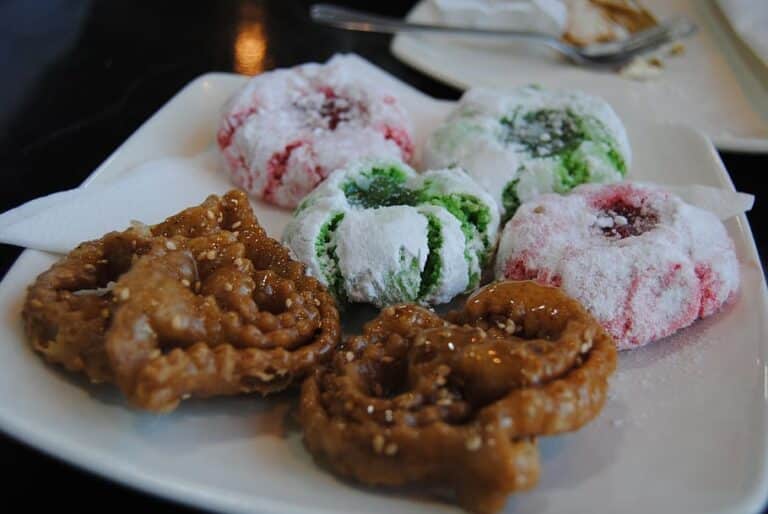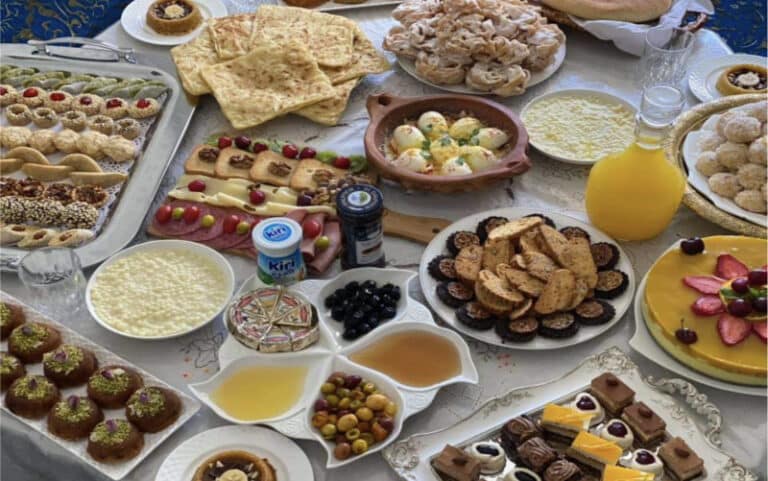1. Pastilla
Pastilla is a delightful Moroccan dessert that combines sweet and savory flavors. This layered pastry features thin sheets of phyllo dough filled with a luscious almond paste mixed with aromatic cinnamon and a touch of orange blossom water. The pastry is baked until golden and then dusted with a sprinkle of powdered sugar and cinnamon, creating a beautiful balance of flavors.
2. M’hanncha
M’hanncha, also known as “Snake Cake,” is a visually stunning Moroccan dessert. This coiled pastry is made with a delicate mixture of almond paste, cinnamon, and orange blossom water. The dough is carefully wrapped around the almond filling, creating a spiral shape resembling a snake. Once baked, the pastry has a crispy exterior with a soft and chewy interior, making it a delightful treat for both the eyes and the taste buds.
3. Sellou
Sellou is a traditional Moroccan sweet delicacy that is often enjoyed during special occasions and festive gatherings. Made with roasted almonds, toasted sesame seeds, flour, butter, honey, and a touch of cinnamon, Sellou has a rich and nutty flavor. It is typically shaped into small balls or patties and dusted with powdered sugar before serving.
4. Chebakia
Chebakia is a delightful Moroccan pastry that showcases intricate folding and deep-frying techniques. The dough is folded into beautiful flower-like shapes and then deep-fried until golden brown. Once fried, Chebakia is dipped in a fragrant honey or syrup mixture and sprinkled with sesame seeds. These indulgent treats have a delicate crunch and a sweet taste that makes them irresistible.
5. Makroud
Makroud is a classic Moroccan dessert that features a combination of sweet dates and semolina dough. The dough is filled with a sweet date paste, shaped into diamond or cylindrical shapes, and deep-fried until golden brown. After frying, the pastries are soaked in honey or syrup, resulting in a decadent and syrupy treat.
6. Baghrir
Baghrir, also known as Moroccan Pancakes or Thousand-Hole Pancakes, is a unique and fluffy pancake-like dessert. Made with a batter of semolina, flour, yeast, and water, Baghrir is cooked on one side only, creating a spongy texture with numerous small holes. These pancakes are typically drizzled with honey or melted butter and served as a delightful sweet breakfast or dessert option.
7. Gazelle Horns
Gazelle Horns are delicate and crescent-shaped cookies that are a beloved Moroccan dessert. These cookies are filled with a sweet almond paste flavored with orange blossom water and cinnamon. The dough is carefully folded around the filling, resulting in a delightful balance of textures and flavors. Gazelle Horns are often dusted with powdered sugar and enjoyed with a cup of tea or coffee.
8. Basbousa
Basbousa is a popular Moroccan dessert made with semolina soaked in a sweet syrup. The semolina cake is often flavored with rose or orange blossom water and sometimes garnished with almonds or coconut. The syrup adds moisture and sweetness, making Basbousa a tender and flavorful treat that is commonly enjoyed during festive occasions.
9. Rghaif
Rghaif is a flaky and layered Moroccan pastry that can be enjoyed as a dessert or a savory treat. The thin dough is typically stuffed with almond paste, honey, or cheese, and then cooked on a griddle or pan until it becomes crispy and golden. The result is a delectable pastry with a delicate crunch and a delightful combination of flavors.
10. Jawhara
Jawhara is a delightful Moroccan dessert that translates to “jewel” in Arabic. This sweet treat consists of layers of buttery pastry filled with a decadent almond paste or a mixture of ground almonds, sugar, and aromatic spices like cinnamon and orange blossom water. The pastries are typically cut into diamond shapes, baked until golden brown, and then dusted with powdered sugar. With its delicate and fragrant flavors, Jawhara truly shines as a gem among Moroccan desserts.


